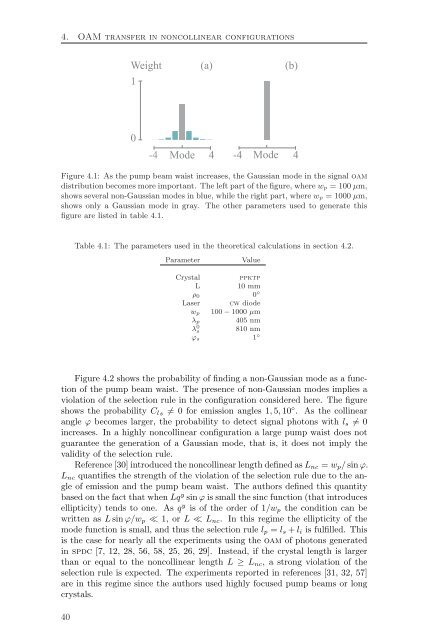Spatial Characterization Of Two-Photon States - GAP-Optique
Spatial Characterization Of Two-Photon States - GAP-Optique
Spatial Characterization Of Two-Photon States - GAP-Optique
You also want an ePaper? Increase the reach of your titles
YUMPU automatically turns print PDFs into web optimized ePapers that Google loves.
4. OAM transfer in noncollinear configurations<br />
Weight<br />
1<br />
0<br />
(a) (b)<br />
-4 Mode 4 -4 Mode 4<br />
Figure 4.1: As the pump beam waist increases, the Gaussian mode in the signal oam<br />
distribution becomes more important. The left part of the figure, where wp = 100 µm,<br />
shows several non-Gaussian modes in blue, while the right part, where wp = 1000 µm,<br />
shows only a Gaussian mode in gray. The other parameters used to generate this<br />
figure are listed in table 4.1.<br />
Table 4.1: The parameters used in the theoretical calculations in section 4.2.<br />
Parameter Value<br />
Crystal ppktp<br />
L 10 mm<br />
ρ0<br />
0◦ Laser cw diode<br />
wp 100 − 1000 µm<br />
λp<br />
405 nm<br />
λ0 s<br />
ϕs<br />
810 nm<br />
1◦ Figure 4.2 shows the probability of finding a non-Gaussian mode as a function<br />
of the pump beam waist. The presence of non-Gaussian modes implies a<br />
violation of the selection rule in the configuration considered here. The figure<br />
shows the probability Cls = 0 for emission angles 1, 5, 10 ◦ . As the collinear<br />
angle ϕ becomes larger, the probability to detect signal photons with ls = 0<br />
increases. In a highly noncollinear configuration a large pump waist does not<br />
guarantee the generation of a Gaussian mode, that is, it does not imply the<br />
validity of the selection rule.<br />
Reference [30] introduced the noncollinear length defined as Lnc = wp/ sin ϕ.<br />
Lnc quantifies the strength of the violation of the selection rule due to the angle<br />
of emission and the pump beam waist. The authors defined this quantity<br />
based on the fact that when Lq y sin ϕ is small the sinc function (that introduces<br />
ellipticity) tends to one. As q y is of the order of 1/wp the condition can be<br />
written as L sin ϕ/wp ≪ 1, or L ≪ Lnc. In this regime the ellipticity of the<br />
mode function is small, and thus the selection rule lp = ls + li is fulfilled. This<br />
is the case for nearly all the experiments using the oam of photons generated<br />
in spdc [7, 12, 28, 56, 58, 25, 26, 29]. Instead, if the crystal length is larger<br />
than or equal to the noncollinear length L ≥ Lnc, a strong violation of the<br />
selection rule is expected. The experiments reported in references [31, 32, 57]<br />
are in this regime since the authors used highly focused pump beams or long<br />
crystals.<br />
40



